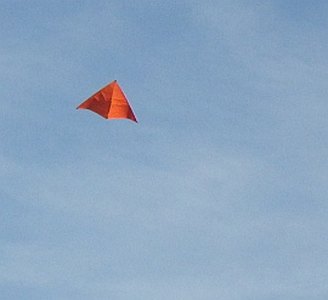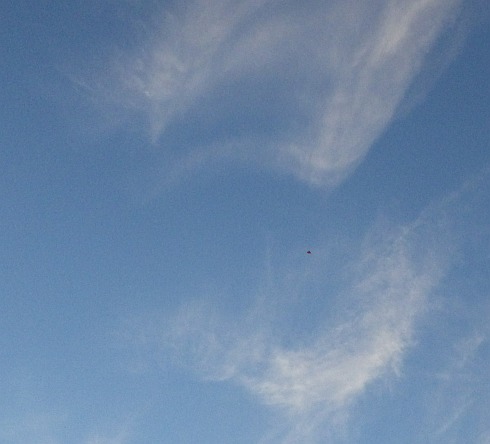- Home Page
- Flight Reports
- Sticked Deltas
- 2-Skewer Delta
2-Skewer Delta Kite
Pinned to the Sunset at 350 Feet
Several days ago, the redesigned 2-Skewer Delta kite, which I am calling the Mk2, first ventured into the air. That was in our small backyard. Just 30 seconds in the air was enough to demonstrate a few good flying characteristics. Of course, that left a strong desire to see what the kite could do on a long light Dacron line over a large field!
 MBK 2-Skewer Delta
MBK 2-Skewer DeltaToday was the day. While en route to the large school reserve, the weather appeared ominously calm. Would there even be enough movement up there to fly at all?
Thankfully, on stepping out of the car, the tiniest of puffs made their presence felt against my face. That would do! Bamboo and plastic is awesome in very light wind. Even so, the first few flights were merely pull ups into fairly dead air. It was interesting to watch the kite descending slowly in tight circles during one such flight. Normally, a kite will drift off downwind when given some slack line, but in zero wind a delta becomes a glider.
As is my style, I just kept on trying, pulling out a little more line each time. It wasn't hard to dance the kite just off the grass while jogging backward and letting line slip. A few quick pull-ins would then send the kite scooting straight upward. In this way, the first signs of a flight-sustaining breeze were discovered up around 50 feet.
So far, the bright-orange delta with black triangular keel was not disappointing—in both the looks and performance departments!
On this site, there's more kite-making info than you can poke a stick at. :-) Want to know the most convenient way of using it all?
The Big MBK E-book Bundle is a collection of downloads—printable PDF files which provide step-by-step instructions for many kites large and small.
That's every kite in every MBK series.
With almost 30 meters (100 feet) of line out, the kite tucked its wing tips in a little and rocketed up in response to a firm pull-in.
Finally, there was enough air movement up there to allow a slow and steady line-of-sight climbout. But not before a few photos and a couple of short videos were taken. Then the climb was continued more or less constantly until all but a couple of turns were left on the winder. That left the 120 meter (400 feet) tag dangling just in front of the tree trunk that was being used as an anchor.
In such a light breeze, and on so much length, even the skinny 20-pound Dacron had quite some sag in it. From the tree, the line went out at just under 45 degrees. The line of sight to the kite itself was more like 55 to 60 degrees. Now it was reward time ... for just standing around and watching awhile! The 2-Skewer Delta kite is just a dot in the cloud photo.
 Can you spot it?
Can you spot it?I had left my kite bag some distance way. While retrieving it, the breeze suddenly died off. The only evidence of this was the line angle of the kite, which had started to decline. The small delta remained almost motionless apart from the very slow but steady descent.
Quickening my pace, I arrived back at the tree just as the breeze put a few kph back on. Again, the only evidence of this was the line flattening out and the kite commencing a steady climb—nice to watch! The kite had bottomed out at a mere 20 degrees or so of elevation from the grass.
Back at full height again, the line near the tree raised and lowered by a few centimeters as subtle changes in wind speed affected the kite. The kite itself was too far away to see any movement at all.
Soon it was time to start winding in. I continued to do this while walking across to where the car was parked. Pausing to check the time, I placed the chunky wooden winder on the grass—where it stayed, successfully holding against the gentle tension in the line.
Below 50 feet, the 2-Skewer Delta kite flew around more chaotically before finally sinking to the grass.
By now, the sun was just minutes from the horizon, with pink hues developing in the sky all around. I held the wind meter up for almost half a minute, but the cups barely moved at all. Zero gusting to zero it read, even at above shoulder height!
It was a very satisfying first high flight for the new delta design. This was despite a tiny lean to the right that was easily fixed with a short bit of tape protruding from one wingtip.
With the right materials and the right line, even quite small kites can brush against the legal altitude limit!
The story or stories above document actual flying experiences. My write-ups are definitely "warts and all," since things don't always go totally as planned. However, half the fun of kiting is anticipating the perfect flight. When it happens, it's magic!
As mentioned earlier, there's more kite-making info here than you can poke a stick at. :-)
Want to know the most convenient way of using it all?
The Big MBK E-book Bundle is a collection of downloads—printable PDF files which provide step-by-step instructions for many kites large and small.
That's every kite in every MBK series.
